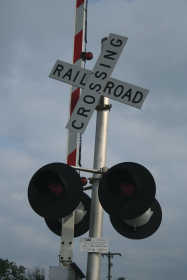Danger of railroad crossings a reality

The death of retired director of the Old National Trail program in Greencastle, Carolyn Jean Davidson, who was killed when a train struck her vehicle in Terre Haute last week has propelled the dangers of railroad crossing to the forefront of the news.
There are no crossing arms at the tracks where she was crossing on the southside of Terre Haute, a fact that creates a particularly dangerous situation.
According to Operation Lifesaver, there were 140 vehicle/train collisions resulting in 19 deaths in Indiana last year.
A large vehicle such as a train appears to be moving slower than it actually is. The maximum speed for freight trains is 60 mph while passenger trains can travel up to 80 mph.
Even at low speeds, the impact force of a train is tremendous. A single locomotive weighing 432,000 pounds traveling at 35 mph will impart a collision force on a car of 885,000 tons of force. In order for an average car to impart that kind of crash force it would have to be traveling more than 4,200 mph.
According to Christine Aldeis, an engineer with BNSF and Operation Lifesaver, trains cannot stop like a car or truck.
"If you are driving a car at 55 mph and slam on the brakes because a child, or something runs out in front of you, you will stop in 200 feet," Aldeis said.
"A train however, traveling at 55 mph and has to slam on the brakes -- meaning every brake on every engine and rail car the engines are pulling -- the train cannot stop for at least a mile or more.
"Think of a football field," she said. "That 55 mph train cannot stop for at least 18 football fields end-to-end."
Once the train's engineer applies the brakes, the train will travel several hundred feet before air pressure is applied to the brakes on all the cars of a train and they fully take hold.
An average freight train takes 1 1/2 miles to come to a complete stop.
Of all the public railroad crossings, only about 53% are controlled by electronic signals. Many private railroad are not marked at all.
There is some good news. Progress has been made with safety. Since 1972 traffic collisions have been reduced 76 percent.
In 1972, there were 12,000 collisions per year on railroad tracks nationwide. In 2008 there were 1,200 collisions with 339 at grade crossing fatalities in 2007 and 486 fatalities in 2008, the most recent statistics. In 2007 there were 2,746 incidents with train/vehicle collisions at railroad crossings.
One of the most important safety precautions for drivers is listening for the train's horn. The train engineer is required to sound the horn within 1,500 feet of a crossing: Two long, one short, one long all the way through the crossing.
"If the engineer sees someone at the crossing that is not paying attention -- and maybe going around the crossing arms, like young people talking on cell phones or listening to music -- he has the right to sound that horn more to get their attention," Aldeis said. "The horn is pretty loud. It's set to get people's attention."
"But people today, with the way cars and trucks are made, they have the windows up, the music on, or a child is crying and distracting them, the air conditioner or heater is on, they may not hear it," she added.
"It's just common sense -- dealing with trains and tracks -- but people don't always use common sense."
Some of the things suggested by Operation Lifesaver include assuming there is a train on every track at all times, even tracks that are rarely used.
If there is a stop sign at the crossing, stop. If there is a yield sign or electronic signals, slow and make sure that no trains are approaching.
If there are two or more tracks, make sure there a train isn't coming in the other direction.
In 2000, a firefighter returning from a false alarm waited at the crossing gates for a northbound train to pass. The train passed and stopped just beyond the crossing. The firefighter drove his fire truck around the gate and was struck and killed by a southbound train whose view was obscured by the stopped northbound train
When stopping at a railroad crossing make sure you stop no less than 15 feet from the tracks.
Never cross a railroad track unless you are sure there is room on the other side for your vehicle to completely clear the tracks. Many collisions occur when a vehicle's rear end is still hanging out over the tracks.
Don't shift gears while crossing a railroad track; it could cause your vehicle to stall.
If your car stalls on a railroad track, get out of the car immediately, clear the tracks and call 911 for help. If a train is coming, run away from the tracks in the direction of the approaching train. If you run away from the approaching train, you may be injured or killed by flying debris when the train smashes into your car.
Never try to beat a train at a crossing or snake around the lowered crossing gates. Once the lights start to flash and the crossing gate arms go down, the train will appear in about 20 seconds.
For more safety information visit Operation Lifesaver's Web site at www.oil.org.
